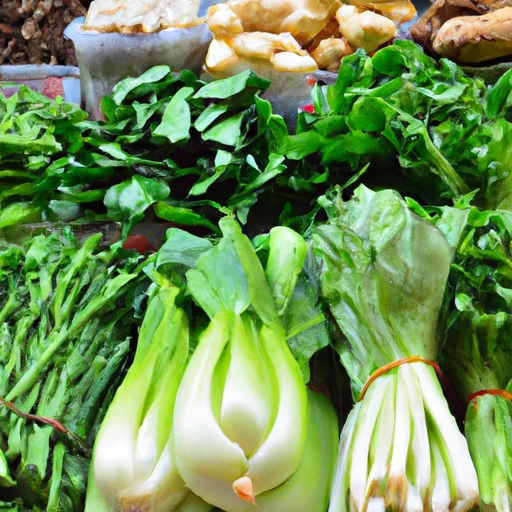Chinese Vegetable
Description

Chinese vegetables encompass a variety of leafy greens and other plant-based ingredients commonly used in Chinese cuisine. This broad category includes bok choy, gai lan (Chinese broccoli), napa cabbage, snow peas, and water chestnuts, among others. These vegetables are cherished for their unique textures, flavors, and versatility in culinary applications. They are a staple in Asian cooking and have gained popularity in American, European, and other international kitchens due to their adaptability in a wide range of dishes.
Common uses
Chinese vegetables are commonly used in stir-fries, soups, salads, and as accompaniments to meat and fish dishes. Their versatility makes them a popular choice for vegetarian and vegan meals as well.
Nutritional value
Calories
Chinese vegetables are generally low in calories. For example, 100 grams (about 3.5 ounces) of bok choy contains approximately 13 calories (54 kJ).
Protein
These vegetables are modest sources of protein. Bok choy provides about 1.5 grams of protein per 100 grams (3.5 ounces).
Fat
Chinese vegetables are typically low in fat, with bok choy containing less than 0.2 grams per 100 grams (3.5 ounces).
Carbohydrates
The carbohydrate content is relatively low, with bok choy offering around 2.2 grams per 100 grams (3.5 ounces).
Vitamins
Chinese vegetables are rich in vitamins, particularly vitamin C and A. A serving of 100 grams of bok choy contains about 45% of the recommended dietary allowance (RDA) for vitamin A and about 75% of the RDA for vitamin C.
Minerals
They are also good sources of minerals like calcium, potassium, and iron. For instance, 100 grams of bok choy has about 105 mg of calcium, 250 mg of potassium, and 0.8 mg of iron.
Health benefits
Chinese vegetables offer various health benefits, including improved digestion, reduced risk of chronic diseases, and enhanced immune system function due to their high vitamin and mineral content.
Potential risks
While generally healthy, Chinese vegetables can be high in nitrates, especially if grown in high-nitrate soils. Excessive consumption of nitrates can lead to health issues, particularly in vulnerable populations.
Common recipes
Recipes like stir-fried bok choy, gai lan with oyster sauce, napa cabbage kimchi, and snow pea salads are common dishes showcasing Chinese vegetables.
Cooking methods
These vegetables can be steamed, boiled, sautéed, roasted, or eaten raw. The key is to cook them briefly to retain their crunch and nutrient content.
Pairing with other ingredients
Chinese vegetables pair well with a variety of ingredients such as garlic, ginger, soy sauce, sesame oil, tofu, chicken, and beef.
Summary
Chinese vegetables are a diverse group of plants widely used in Asian cuisine and increasingly popular worldwide. They provide a wealth of nutritional benefits, are low in calories, and can be prepared in various ways to complement a multitude of dishes. Their rich vitamins and minerals profile make them a healthful addition to any diet, though they should be consumed in moderation due to potential nitrate content. As the world becomes more culinary diverse, Chinese vegetables continue to cross cultural boundaries, bringing their unique flavors and textures to food lovers everywhere.